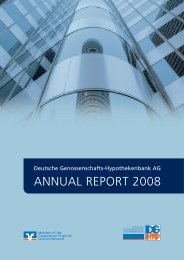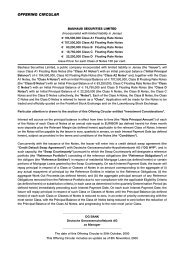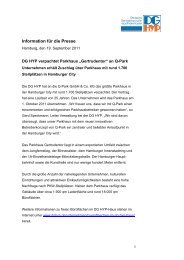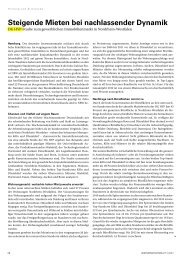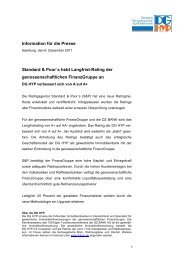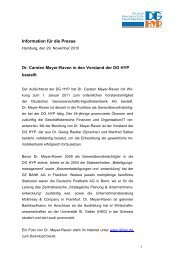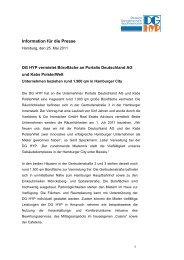Covered Bonds - DG Hyp
Covered Bonds - DG Hyp
Covered Bonds - DG Hyp
You also want an ePaper? Increase the reach of your titles
YUMPU automatically turns print PDFs into web optimized ePapers that Google loves.
<strong>DG</strong> HYP COVERED BONDS – PFANDBRIEFE – QUALITY THE PATH OUT OF THE CRISIS SPECIAL MAY 2009<br />
Illustrative liquidity-gap calculation<br />
Day Cover pool<br />
cash flow<br />
Pfandbrief<br />
cash flow<br />
Daily<br />
variance<br />
Cumulative<br />
variance<br />
1 50 0 50 50<br />
2 100 50 50 100<br />
3 80 0 80 180<br />
4 50 100 -50 130<br />
5 100 400 -300 -170<br />
6 50 0 50 -120<br />
7 80 0 80 -40<br />
8 70 80 -10 -50<br />
9 50 100 -50 -100<br />
… 0 -100<br />
… 0 -100<br />
180 110 0 110 10<br />
Source: DZ BANK<br />
Our understanding of the approach for calculating the minimum necessary liquidity<br />
requirement is that the bank determines each day’s variances (between cash inflows and<br />
outflows) for a 180-day period, and adds these together to give the same number of<br />
cumulative daily variances. The resulting biggest negative cumulative daily variance – only<br />
the negative totals that stem from a cover shortfall present a risk that requires managing –<br />
has to be remedied by cover and overcollateralisation in the form of ECB-eligible assets.<br />
Our example shows a liquidity gap of EUR 170,000 on day 5.<br />
Although the question of liquidity gaps caused by excessive maturity transformation in the<br />
cover pool only becomes important when things get serious (the issuer-insolvency scenario<br />
with subsequent separation of the cover pool), it is precisely this issue that not only the<br />
rating agencies but also investors are zooming in on when rating and analysing covered<br />
bonds and specifically pfandbriefe. This new regime has seen the legislators move a long<br />
way in the direction of the permanent liquidity reserves that the rating agencies have called<br />
for. In the present crisis situation however, even a 180-days cover period can be criticised<br />
as inadequate seeing that a broad-based systemic crisis can never be definitely ruled out. In<br />
this scenario however, absolutely strict cover matching would be the only way to guarantee<br />
real security – and this requirement would be pretty difficult to impose on issuers (mainly,<br />
but not solely, on cost considerations).<br />
Cumulative daily variances<br />
Absolute certainty is impossible to<br />
guarantee in practice<br />
24





